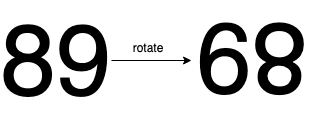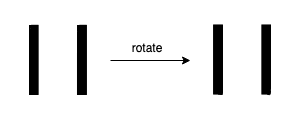Welcome to Subscribe On Youtube
1056. Confusing Number
Description
A confusing number is a number that when rotated 180 degrees becomes a different number with each digit valid.
We can rotate digits of a number by 180 degrees to form new digits.
- When
0,1,6,8, and9are rotated180degrees, they become0,1,9,8, and6respectively. - When
2,3,4,5, and7are rotated180degrees, they become invalid.
Note that after rotating a number, we can ignore leading zeros.
- For example, after rotating
8000, we have0008which is considered as just8.
Given an integer n, return true if it is a confusing number, or false otherwise.
Example 1:

Input: n = 6 Output: true Explanation: We get 9 after rotating 6, 9 is a valid number, and 9 != 6.
Example 2:

Input: n = 89 Output: true Explanation: We get 68 after rotating 89, 68 is a valid number and 68 != 89.
Example 3:

Input: n = 11 Output: false Explanation: We get 11 after rotating 11, 11 is a valid number but the value remains the same, thus 11 is not a confusing number
Constraints:
0 <= n <= 109
Solutions
-
class Solution { public boolean confusingNumber(int n) { int[] d = new int[] {0, 1, -1, -1, -1, -1, 9, -1, 8, 6}; int x = n, y = 0; while (x > 0) { int v = x % 10; if (d[v] < 0) { return false; } y = y * 10 + d[v]; x /= 10; } return y != n; } } -
class Solution { public: bool confusingNumber(int n) { vector<int> d = {0, 1, -1, -1, -1, -1, 9, -1, 8, 6}; int x = n, y = 0; while (x) { int v = x % 10; if (d[v] < 0) { return false; } y = y * 10 + d[v]; x /= 10; } return y != n; } }; -
class Solution: def confusingNumber(self, n: int) -> bool: x, y = n, 0 d = [0, 1, -1, -1, -1, -1, 9, -1, 8, 6] while x: x, v = divmod(x, 10) if d[v] < 0: return False y = y * 10 + d[v] return y != n -
func confusingNumber(n int) bool { d := []int{0, 1, -1, -1, -1, -1, 9, -1, 8, 6} x, y := n, 0 for x > 0 { v := x % 10 if d[v] < 0 { return false } y = y*10 + d[v] x /= 10 } return y != n } -
class Solution { /** * @param Integer $n * @return Boolean */ function confusingNumber($n) { $d = [0, 1, -1, -1, -1, -1, 9, -1, 8, 6]; $x = $n; $y = 0; while ($x > 0) { $v = $x % 10; if ($d[$v] < 0) { return false; } $y = $y * 10 + $d[$v]; $x = intval($x / 10); } return $y != $n; } }